Which animals do you think are the smartest? Perhaps dolphins, orcas, horses, chimpanzees, octopuses, or dogs come to mind for you. It is true that each of these is often counted as among the most clever creatures in the world. In general, mammals like cats, rats, dogs, and horses make great pets. Part of the reason for this is that they have reputations for being intelligent, learning commands, and picking up tricks. You may notice that this list does not include any birds. However, many bird species have been found to be incredibly smart. This round-up of the smartest birds in Canada provides ample examples of this.
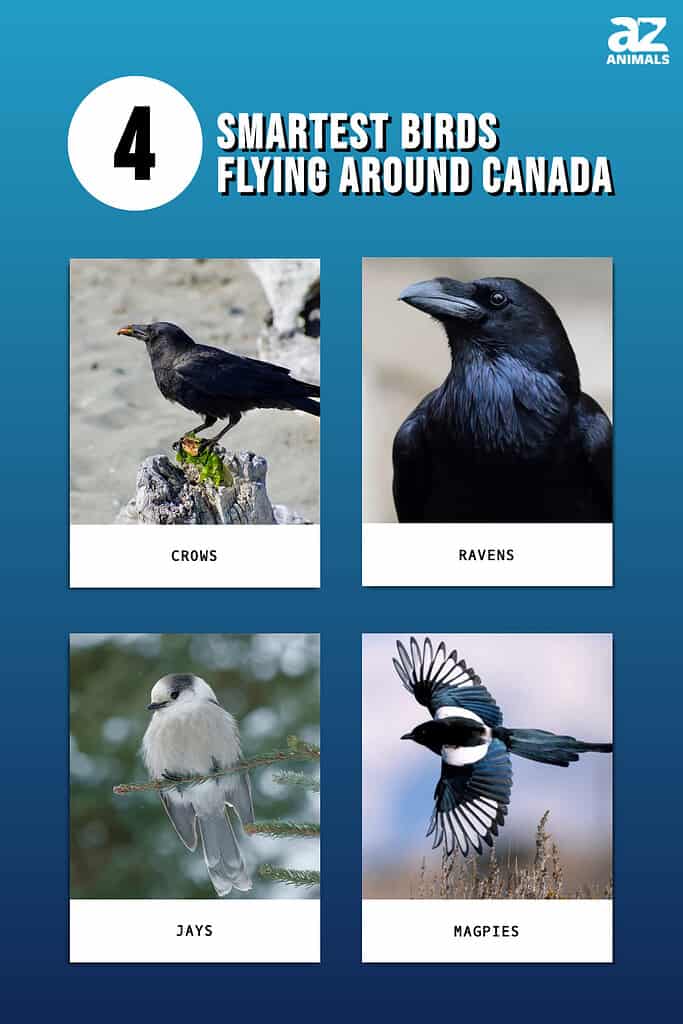
Overall, mammals tend to have larger brains than their feathered counterparts. However, a bigger brain is not necessarily an indicator of intelligence! Some even have intellectual capabilities on the same level as a small human child. It is certainly worth learning about some of the most exceptionally intelligent birds in the world. The list of smartest birds in the United States is also very impressive. However, this article specifically zooms in on the smartest birds flying around and building their nests in their native Canada. Let’s dive in together to learn about the smartest birds in Canada now!
1. Crows
First on the list of smartest birds in Canada is the crow. Birds in the Corvidae family are known to be some of the smartest birds that people have studied. In certain studies, these “corvid” birds have shown remarkable intelligence. Studies have suggested they have the ability to find and use tools, recognize their own image in a mirror, and collect objects. The Corvidae family includes birds such as crows, jays, ravens, and magpies. Therefore, it should not be any surprise that the first species on the list of smartest birds in Canada is the American crow (Corvus brachyrhynchos).
American crows live throughout a variety of habitats across Canada, including in forests, fields, marshes, parks, and developed residential neighborhoods. There are about 32 different species of crows in addition to several subspecies. However, in Canada, the American crow is one of the most common. The American crow is widespread across the country, making one of Canada’s smartest birds also one of the most common.
Crow Intelligence
Certain studies show that American crows are more intelligent than certain species of apes. They could be only slightly less intelligent than a young human child. Some research suggests that American crows have the ability to reason, solve problems, and recognize human faces.
In addition to that, though crow communication is not well understood by scientists, some researchers believe that crows use a rhythm, frequency, and amount of calls and caws that parallels human language. They have demonstrated the capacity to make decisions as a group, solve problems together, and make their own tools using natural resources. Some research has even shown crows counting up to five.
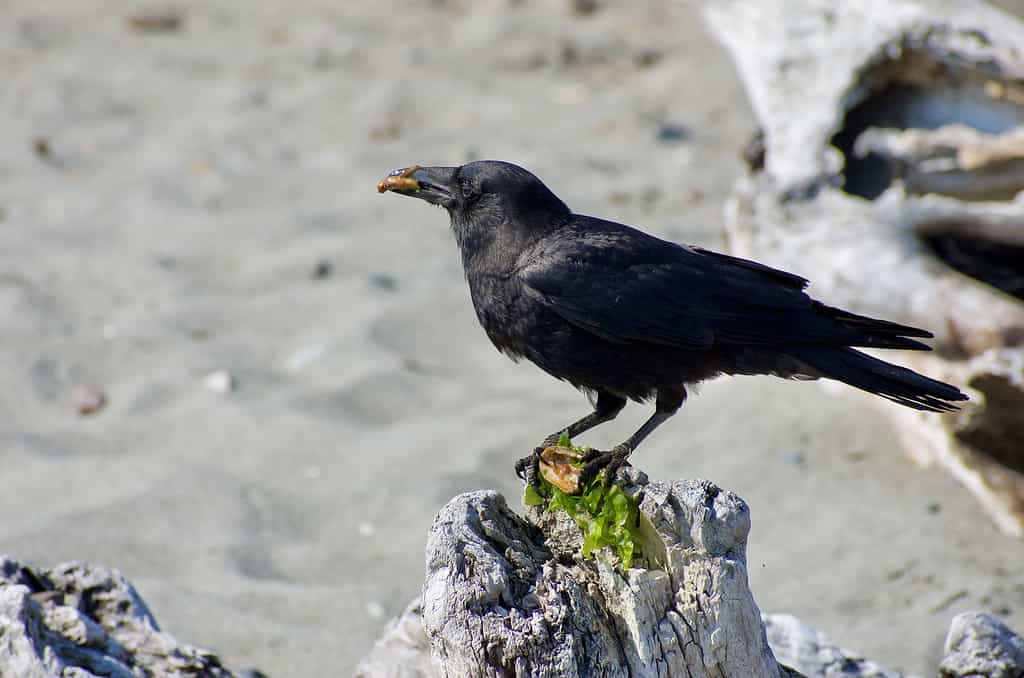
American crows are among the smartest birds in North America. The photo above shows one perched on driftwood on Vancouver Island in British Columbia, Canada.
©iStock.com/DanielLacy
2. Ravens
Next on the list is the raven, another member of the Corvus genus in the Corvidae family of birds. The common raven (Corvus corax) is a black-colored songbird. It lives in many habitats across the Northern Hemisphere, including in Canada. Dating back thousands of years, the raven has had great significance to the indigenous people who inhabit the land that is now the country of Canada. These birds have a long lifespan, living up to 21 years in the wild. The common raven is the only raven species native to Canada. Yet across the country, you can find this bird breeding in the cold arctic islands to warmer parts of the country. In fact, this bird is extremely widespread and can be found in a range of environmental conditions.
Raven Intelligence
The birds are known for their great intelligence. Some ravens have demonstrated the ability to problem-solve, understanding cause and effect and finding solutions to address problems they encounter. Ravens also have complex social dynamics and communicate their knowledge to other birds in their group. Some research has even shown that ravens can cooperate and even play with each other. In fact, there are some studies showing evidence of ravens playing tricks on each other or seeming to deceive other animals.
One place where the raven’s intelligence shines is in their hunting strategies. Ravens have been spotted working in pairs. They collaborate to achieve a goal, with one bird creating a diversion to trick another animal while its partner snatches a baby animal or egg.
Ravens also have the unique ability to imitate the sounds of other animals. You have likely heard parrots copy people speaking, but have you ever heard a raven ask “Polly want a cracker?” Though it may be surprising, certain ravens, when held in captivity, have been taught how to imitate the sound of other bird calls, street noises, and even that of a human voice saying “hello.”
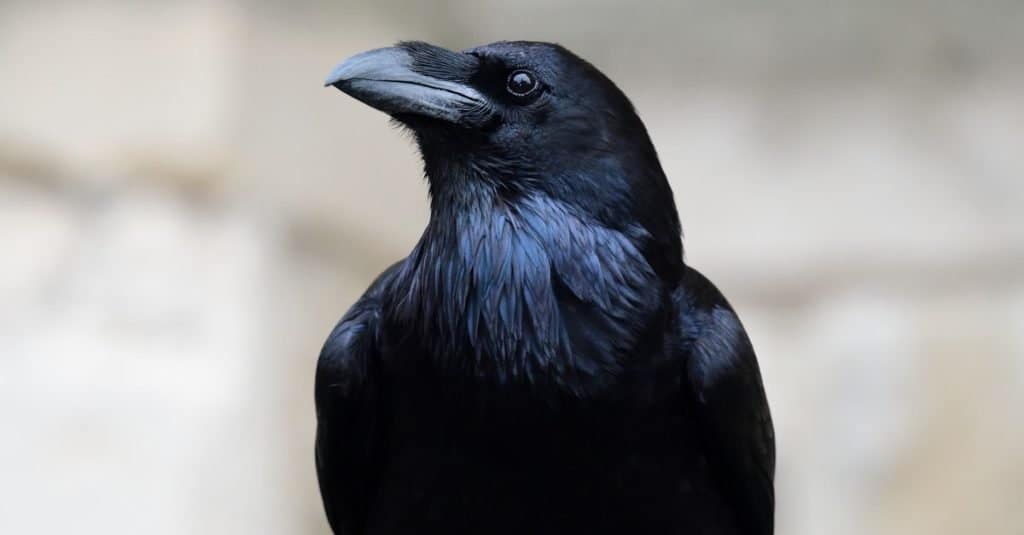
Common ravens have complex social dynamics and communication patterns, problem-solve, and have been known to play tricks on other animals.
©iStock.com/Tom Meaker
3. Jays
Third on the list is yet another member of the Corvidae family: the jay. There are about 40 species of jay in the world. Canada is home to three. These are the blue jay (Cyanocitta cristata), Steller’s jay (Cyanocitta stelleri), and the gray jay (Perisoreus canadensis), which is also known as the Canada jay. Each of these species of jay are known for being lively, intelligent birds.
Jay Intelligence
Studies have shown that blue jays remember the many different locations where they have stored acorns buried in the ground. Like other members of Corvidae, jays have also shown a capacity to use tools to problem-solve. For example, a group of jays raised in captivity in a lab at the University of Massachusetts used tools to access food pellets kept outside of their cage.
Other similarities that jays share with other Corvidae birds, such as ravens, is the ability to produce a wide range of sounds and a talent for imitating other animals. For example, a blue jay can copy the calls of other birds. A blue jay can pretend to be a predator, like a hawk. This will scare away other birds from a birdfeeder and leave the jay to enjoy all of the tasty food morsels itself. Steller’s jays have been shown mimicking the sounds of other creatures too, such as the noises of squirrels, dogs, and cats.
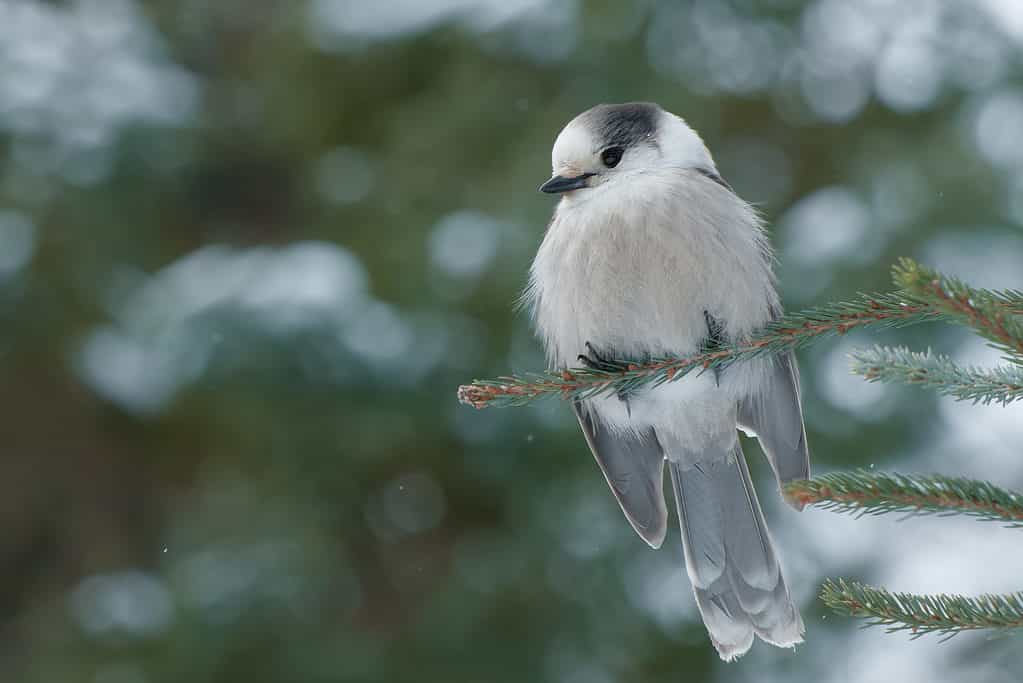
Gray jays are also called “Canada jays” because they were chosen to be the national bird of Canada.
©Paul Reeves Photography/Shutterstock.com
4. Magpies
Fourth on the list is the magpie, or the black-billed magpie (Pica hudsonia), to be more precise. These noisy black and white birds live in parts of western Canada and the northwestern United States, where you may often see them in meadows or grasslands eating fruit, grains, and small insects. Black-billed magpies are another extremely intelligent member of the Corvidae family of birds. People may get annoyed at the noise that magpies make, particularly because they often travel in groups and are known for behaving aggressively toward other bird species. However, these super-smart birds have shown their intelligence in multiple experiments.
Magpie Intelligence
One study showed that magpies recognize themselves in a mirror, which is a rare trait among animals that is typically only seen in apes, dolphins, and elephants. Like some of the other birds on this list, magpies have also shown the ability to make and use tools. They are famous for imitating noises, including human speech. Scientists believe they have observed magpies playing games and working in teams.
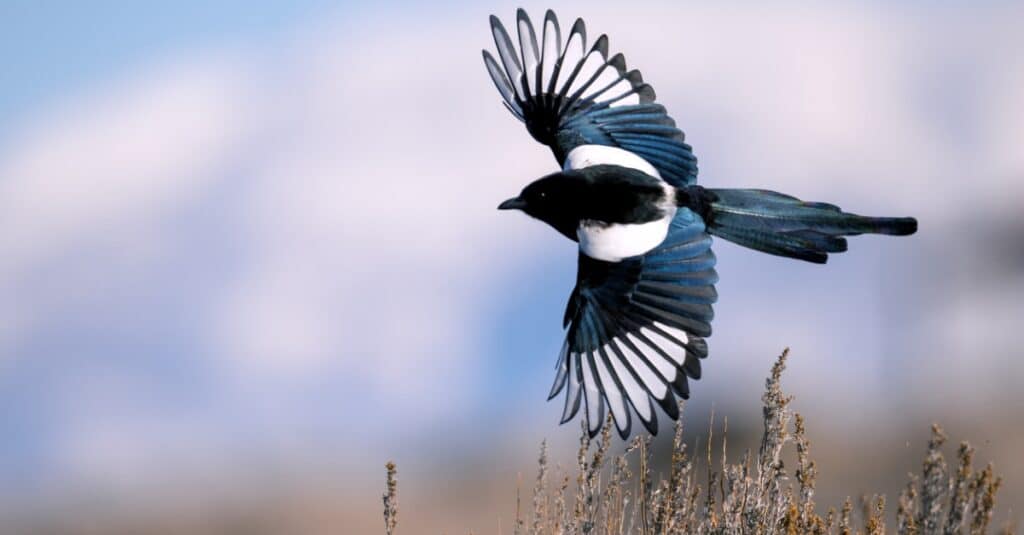
The black-billed magpie is known for being noisy and chattering with other birds but is also among the smartest bird species in Canada.
©iStock.com/kojihirano
Smartest Birds in Canada: Honorable Mentions
Though they did not make it to the top of our list, there are a few other birds that deserve an honorable mention as among the smartest birds in Canada. First, woodpeckers could be among the contenders for the most intelligent bird. More research is needed, but scientists are intrigued. Like jays, they save nuts to eat later, indicating long-term memory. Scientists are also interested in the way that woodpeckers use their sharp beaks as a tool to peck insects from trees and wedge food into hard-to-reach places. 14 woodpecker species live in Canada!
Robins, like crows, also have shown the ability to remember human faces and recognize them again in the future. Watch out for the American robin, which breeds in Canada before migrating south during the fall and winter. These birds are not as smart as jays, but are very adaptable. They can quickly adapt to a new area and discover food and shelter even in places where they have never been before.
Great herons use tools to problem-solve. How do you catch a fish as a heron? Why not try using bait? Herons have been seen using pieces of bread to lure fish to the surface of the water. What a smart way to go fishing! Great herons live across Canada’s wetland areas.
The last honorable mention on our list is the mockingbird, which is another talented copycat with a penchant for imitating other animals. Much like the magpie, jay, or raven, mockingbirds can mimic the cries of other birds and animals to scare off other birds. Mockingbirds do not live in most of Canada, but do make their way into parts of southern Ontario and Quebec and New Brunswick.
In Summary
What makes the behaviors described above so important? Taken on their own, these individual actions may not seem significant. However, scientists who study birds actually think that each of these behaviors suggests bird intelligence because they suggest that the birds are not simply acting out of instinct.
The examples described above seem to show that crows, ravens, jays, and magpies are thinking. Their ability to remember, recognize faces, imitate sounds, play games, make tools, and more seems to require reasoning and problem-solving ability. These qualities are associated with the intellectual abilities of a human lost in thought.
However, these birds do not have language. Or do they? Some scientists even believe that the complex rhythms of certain bird species suggest these creatures might have a communication pattern similar to language, all of their own. Thinking about this opens a window into understanding how both birds and humans think, offering a whole new way to view the world! Next time you see a crow, raven, jay, or magpie, pay attention to their behavior. You might observe them interacting with each other, watch one use a tool, or communicate in an interesting way that suggests these birds in Canada are smarter than we know.
Summary of the Top 4 Smartest Birds Flying Around Canada
| Name of Bird | Abilities |
|---|---|
| Crow | Can use tools, recognize own image in mirror, reason and problem-solve, recognize human faces, make decisions as a group, collect objects, and maybe count; has complex communication skills |
| Raven | Can problem-solve; cooperate, work, and play together; imitate sounds; and has complex social dynamics and communications, |
| Jay | Can use tools, remember locations, and imitate sounds. |
| Magpie | Can use tools, recognize own image in mirror, imitate sounds (including human speech), play games and work in teams. |
The photo featured at the top of this post is © Karel Bock/Shutterstock.com
Thank you for reading! Have some feedback for us? Contact the AZ Animals editorial team.







